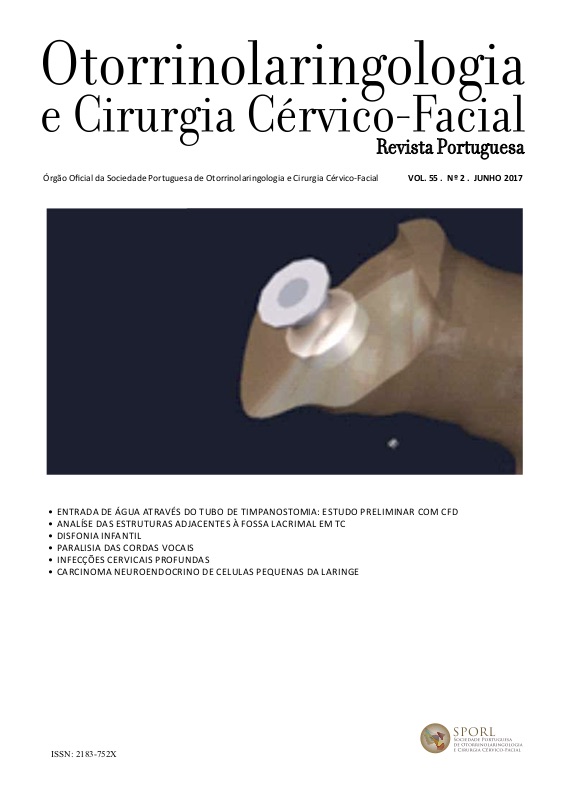Deep neck infections - Prognostic complications factors analysis
DOI:
https://doi.org/10.34631/sporl.367Keywords:
Deep neck infection, microbiology, computed tomography, treatment, complicationsAbstract
Objective: Review the experience of our department between 2009 and 2014, with deep neck infections (DNI) and compare it with the previous years. Identify independent significant factors influencing prognosis in terms of complications.
Material and Methods: Retrospective analysis of 223 consecutive adult patients with DNI, admitted to the Otorhinolaryngology Service, between 2009 and 2014. The results were compared with those of a similar previous study. Aiming to identify independent prognostic factors of complications, a Cox regression was applied.
Results: There was an average increase of hospitalizations per year of 58.3% and a decrease in mortality by half (1.3%). Advanced age, dental infection, multiple abscesses, dyspnea and neck swelling were independently significant in prognosticating complications of DNI.
Conclusion: Deep neck infections are life-threatening clinical entities. The reduction in mortality may be related to changes in diagnostic techniques, use of broad spectrum antibiotic protocol and with the achievement of early surgical treatment. An older age, dental etiology, involvement of multiple cervical spaces, dyspnea and cervical swelling at presentation were identified as independent predictors of complication.
Downloads
References
Celavosky P, K.D., Tucek L, et al, Deep neck infections: risk factors for mediastinal extension. Eur Arch Otorhinolaryngol, 2013.
Santos Gorjón P, B.P.P., Morales Martín AC, Del Pozo de Dios JC, Estévez Alonso S, Calle de la Cabanillas MI, Deep neck infection. Review of 286 cases. Acta Otorrinolaringol Esp, 2012. 63: p. 31-41.
Bakir S, T.M., Gun R, et al, Deep neck space infections: a retrospective review of 173 cases. Am J Otolaryngol, 2012. 33: p. 56-63.
I, B., Microbiology and management of peritonsillar, retropharyngeal, and parapharyngeal abscesses. J Oral Maxillofac Surg, 2004. 62: p. 1545-50.
Suehara AB, G.A., Alcadipant FA, Kavabata NK, et al, Infecções cervicais profundas: análise de 80 casos. Rev Bras Otorrinolaringol, 2008. 74: p. 253-9.
Wang LF, K.W., Tsai SM, et al, Characterizations of life-threatening deep cervical space infections: a review of 196 cases Am J Otolaryngol, 2003. 24: p. 111-7.
Chen MK, W.Y., Chang CC, Huang MT, Hsiao HC, Deep neck infections in diabetic patients. Am J Otolaryngol, 2000. 21(3): p. 169-73.
Huang TT, L.T., Chen PR, et al, Deep neck infection: analysis of 185 cases. Head Neck 2004. 26: p. 854-60.
GW, L., Cervical fascia and deep neck infections. Laryngoscope, 1970. 80: p. 409-35.
Boscolo-Rizzo P, M.C., Montolli F, Vaglia A, et al, Deep neck infections: a constant challenge. J Otorhinolaryngol, 2006. 85: p. 259-65.
Eftekharian A, R.N., Vaezeafshar R, Narimani N, Deep neck infections: a retrospective review of 112 cases. Eur Arch Otorhinolaryngol, 2009. 266(2): p. 273-7.
Parhiscar A, H.-E.G., Deep neck abscess: a retrospective review of 210 cases Ann Otol Rhinol Laryngol, 2001. 110: p. 1051-4.
Bottin R, M.G., Rinaldi R, et al, Deep Neck Infection: a present-day complication. A retrospective review of 83 cases (1998-2001). Eur Arch Otorhinolaryngol, 2003. 260: p. 576-9.
Plaza Mayor G, M.-S.M.J., Martinez-Vidal A, Is conservative treatment of deep neck space infections appropriate? . Head Neck, 2001. 23: p. 126-33.
Lin HT, T.C., Chen YL, et al, Influence of diabetes mellitus on deep neck infection. J Laryngol Otol, 2006. 120: p. 650-54.
Leibovici L, Y.Y., Porter A, Influence of diabetes mellitus and glycaemic control on the characteristics and outcome of common infections. Diabetic Med, 1996. 13: p. 457-63.
Lassmann B, G.D., Wood CM, et al, Reemergence of anaerobic bacteremia. Clin Infect Dis, 2007. 44: p. 895-900.
Nagy M, B.J., Comparison of the sensitivity of lateral neck radiographs and computed tomography scanning in pediatric deep-neck infections. Laryngoscope, 1999. 109: p. 775-79.
Smith II JL, H.J., Chang J, Predicting deep neck space abcess using computed tomography. Am J Otolaryngol, 2006. 27: p. 244-7.
Osborn TM, A.L., Bell RB, Deep space neck infection: principles of surgical management. Oral Maxillofac Surg Clin North Am, 2008. 20: p. 353-65.
Brook I, F.P.J., Comparison of the microbiology or recurrent tonsillitis between children and adults. Laryngoscope, 1986. 96: p. 1385-8.
Johnson RF, S.M., Wright CC, An evidence-based review of the treatment of peritonsillar abscess. Otolaryngol Head Neck Surg, 2003. 128(3): p. 332-43.
Boscolo-Rizzo P, S.M., Muzzi E, Mantovani M, et al, Deep Neck infections: a study of 365 cases highlighting recommendations for management and treatment. Eur Arch Otorhinolaryngol, 2012. 269: p. 1241-49.
Liu SA, L.M., Wang CO, et al, Preoperative blood sugar and C-reactive protein associated with persistent discharge after incision and drainage for patients with deep neck abscesses. Clin Otolaryngol, 2009. 34: p. 336-42.






